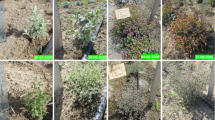Abstract
Cordeauxia edulis, the yeheb (yicib, ye-eb), has attracted much interest as a potential multi-purpose shrub well adapted to (semi)arid conditions. Since there exist only limited information and analyses, mainly of the seeds, we try to answer some questions arising about site conditions, soil requirements, and, by leaf analyses, the state of nutrition. Finally we determined the fodder-value of the foliage, as the bush is grazed too. Our results underline the low requirements of the yeheb for water and soil fertility.
Similar content being viewed by others
Literature Cited
Allen, O. N., and E. K. Allen. 1981. The Leguminosae, a source book of characteristics, uses, and nodulation. University of Wisconsin Press, Madison.
Anonymous. 1908. Yeheb. Kew Bull. 1908:36–44, 141.
—. 1910. Yeheb. Kew Bull. 1910:398–400.
Bally, P. R. O. 1966. Miscellaneous notes on the flora of Tropical East Africa, 29. Enquiry into the occurrence of the Yeheb nut (Cordeauxia edulis Hemsl.) in the Horn of Africa. Candollea 21(1):3–11.
Boudet, G. 1978. Manuel sur les pâturages tropicaux et les cultures fourragères. I.E.M.V.T., Etude Agrostologique Nr. 4, Ministère Coop., Paris.
Chiovenda, E. 1929. Flora Somala. Sindacato Italiano Arti Grafiche, Rome.
El-Zeany, B. A., and S. F. Gutale. 1982. The nutritional value of Yeheb-nut(Cordeauxia edulis Hemsl.). Die Nahrung 26(9):797–802.
E.M.A. (Ethiopian Mapping Agency). 1981. National atlas of Ethiopia. E.M.A., Addis Ababa.
FAO. 1977. Water use in irrigated agriculture, Democratic Republic of Somalia, a country brief. FAO, Rome.
Glover, P. E. 1950. The root systems of some British Somaliland plants I. E. African Agric. J. 16:98–113.
Greenway, P. J., and W. D. Raymond. 1947. Yeheb. E. African Agric. J. 12:216–219.
Griffiths, J. F. 1972. The Horn of Africa. Pages 133–165in J. F. Griffiths, ed., World survey of climatology, vol. 10, Climates of Africa. Elsevier Publ. Co., Amsterdam.
Gutale, S. F., and M. A. Ahmed. 1984.Cordeauxia edulis pigment, cordeauxiaquinone, is deposited on bones and may stimulate hemopoiesis in rats. Rivista Tossicol. Sperim. Clin. 14(1–2):57–62.
Hemming, C. F. 1966. The vegetation of the northern region of the Somali Republic. Proc. Linn. Soc. London 177(2):173–250.
—. 1972. Survey of Northern Rangelands, Somali Democratic Republic. Ecological and grazing survey of the Mudugh region. United Nations Development Programme, FAO, Rome.
Hunt, J. A. 1951. A general survey of the Somaliland Protectorate 1944–1950. Crown Agents, London.
Laves, D., and G. Jähn. 1972. Zur quantitativen röntgenographischen Bodenton-Mineral-Analyse. Arch. Acker-, Pflanzenbau u. Bodenkunde 16:735–739.
Lister, J. H., C. H. Eugster, and P. Karrer. 1955. Cordeauxia-chinon, ein BlattfarbstoffausCordeauxia edulis. Helv. Chim. Acta 38(1):215–222.
Macfadyen, W. A. 1950. Vegetation patterns in the semidesert plains of British Somaliland. Geogr. J. 116:199–211.
Merla, G., E. Abbate, A. Azzaroli, P. Bruni, P. Canuti, M. Fazzuoli, M. Sagri, and P. Tacconi. 1979. A geological map of Ethiopia and Somalia (1973) 1:2,000,000 and Comment. Consiglio Nazionale delle Ricerche, Firence.
Miège, J., and M.-N. Miège. 1978.Cordeauxia edulis—a Caesalpiniaceae of arid zones of East Africa. Econ. Bot. 32:336–345.
Minson, D. J. 1977. The chemical composition and nutritive value of tropical legumes. Pages 186–194in P. J. Skerman, Tropical forage legumes. FAO, Rome.
Mohr, P. A. 1962 (reprint 1971). The geology of Ethiopia. Central Printing Press, Addis Ababa.
N.A.S. (National Academy of Sciences). 1979. Tropical legumes: Resources for the future. N.A.S., Washington, DC.
Page, A. L., R. H. Miller, and D. R. Keeney. 1982. Methods of soil analysis. Agronomy No. 9, part 2. Amer. Soc. Agron., Soil Sci., Soc. Amer., Madison, Wisconsin.
Roti-Michelozzi, G. 1957. Adumbratio florae Aethiopicae. Webbia 13(1):187–193.
Schlichting, E., and H.-P. Blume. 1966. Bodenkundliches Praktikum. Paul Parey Verlag, Hamburg.
Thulin, M. 1983. Leguminosae of Ethiopia. Opera Bot. 68.
Watson, R. M., C. I. Tippett, J. J. Beckett, and V. Scholes. 1982. Somali Democratic Republic, Central Rangelands Survey, vol. 1, part 1 and 3. Resource Management & Research, London.
White, F. 1983. The vegetation of Africa. UNESCO, Paris.
Zech, W. 1981. Futterwert forstlicher Pflanzen im Sahel. Weltforum Verlag, München.
Author information
Authors and Affiliations
Rights and permissions
About this article
Cite this article
Drechsel, P., Zech, W. Site conditions and nutrient status ofCordeauxia edulis (Caesalpiniaceae) in its natural habitat in Central Somalia. Econ Bot 42, 242–249 (1988). https://doi.org/10.1007/BF02858926
Received:
Accepted:
Issue Date:
DOI: https://doi.org/10.1007/BF02858926




